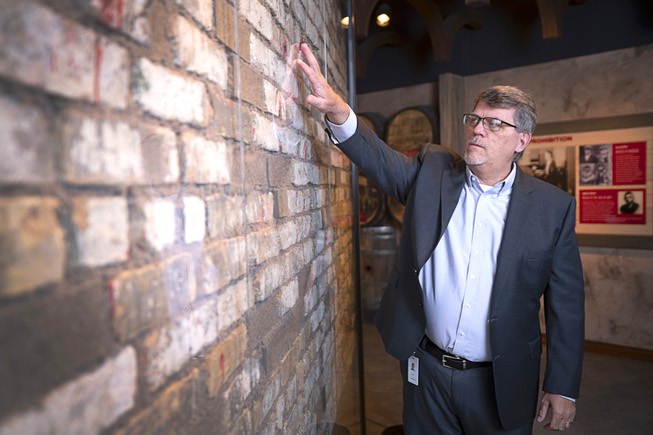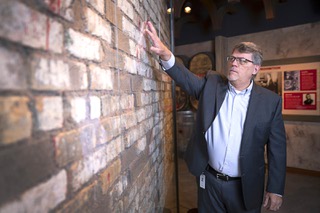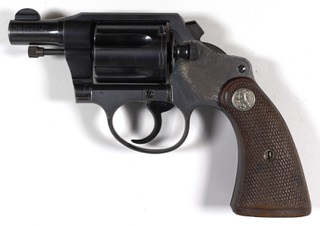
Geoff Schumacher, vice president of exhibits and programs at the Mob Museum, the National Museum of Organized Crime and Law Enforcement, looks over a section of the St. Valentine’s Day Massacre wall the Mob Museum in downtown Las Vegas Friday, Feb. 10, 2023.
Tuesday, Feb. 14, 2023 | 2 a.m.
While couples celebrate Valentine’s Day today in Las Vegas, the downtown Mob Museum will be marking the 94th anniversary of one of the most notorious gangland murders in organized crime history.
The holiday is also the anniversary of one of the most infamous organized crime events in U.S. history: On Feb. 14, 1929, seven members of a Chicago gang were ambushed and brutally murdered in what would become known as the St. Valentine’s Day Massacre.
Nearly a century later, the Mob Museum is playing host to a special presentation of several items from the crime scene, including weapons linked to the shooting, a gun belonging to one of the victims and letters written by mob boss Al Capone — who is believed by many to have been responsible for the massacre.
The exhibit will coincide with the 11th anniversary of the museum’s opening, which will be commemorated with free admission for locals and buy-one-get-one ticket prices for tourists.
“Everything got separated,” Geoff Schumacher, vice president of exhibits and programs at the Mob Museum, said of the artifacts, which will be on display today. “They got moved, and now we’re bringing all that back together for this pivotal moment.”
Among the artifacts on display for the first time are three letters written by Capone, as well as a home video the mob boss made at his mansion in Miami Beach, Fla., that all provide interesting insight into the infamous mobster’s life, Schumacher said.
In one letter written during Prohibition, Capone asks a friend, Bill Sells, to summon a bootlegger from whom he had bought whiskey to Chicago — presumably so he could buy more whiskey, Schumacher said. In another letter, Capone writes to his son from Alcatraz where he is imprisoned and describes making music with other inmates to pass the time.
And in the third letter, written shortly after the St. Valentine’s Day Massacre, Capone writes to Sells from prison and asks him to find a piece of property for him. Historically, this would be around a time Capone was considering getting away from mob activity, Schumacher said.
“And so, he wanted this property, presumably in Wisconsin, where he could go and hunt and fish and, you know, kind of get away from it all,” Schumacher said.
The museum also recently acquired at auction a gun that belonged to one of the victims of the massacre, Frank Gusenberg. Unlike the other six victims, Gusenberg — who was shot 14 times — did not die at the scene, Schumacher said.
The gun, believed to have been lost by Gusenberg during the shooting, was separated from the rest of the crime scene evidence after it was recovered, Schumacher said.
“Frank Gusenberg did not die right away,” Schumacher said. “He died about three hours later in the hospital, but he was laying there on the ground when everybody came in. And there was one gun on the floor, and it was this pistol that Gutenberg had — they believed it was his. So that became part of the evidence from the crime scene.”
The two Thompson machine guns, or “Tommy guns” linked to the massacre will also be on display. Officials said guns are being loaned to the museum for the day by the Berrien County, Mich., Sheriff’s Office, where they are kept.
“There’s always a big turnout for these anniversary events,” he said. “And there are a lot of people who haven’t been able to come to the museum for whatever reason. So, we just love to share all this material with them.”
Some of the artifacts on display today will reappear Saturday, Schumacher said, including the Gusenberg gun and the three Capone letters.
The Mob Museum — which is the permanent home to other artifacts of the St. Valentine’s Day Massacre, including a brick wall from the building in which it took place — continues to garner interest after more than a decade, which Schumacher attributed not only to the history of organized crime in Las Vegas, but a public fascination in organized crime overall.
“Through the movies, through TV shows, through comic books, through every medium you can think of — the mob is part of our culture, as well as law enforcement,” he said. “And so, we really try to tell that story — how organized crime operated, who some of the players were, what kinds of things they were doing — but we also tell the story about law enforcement, how they responded to organized crime and how they dealt with it.”


